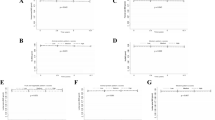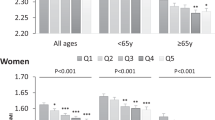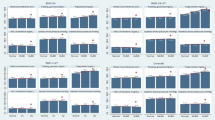Abstract
Background/Objectives:
To examine the associations of dietary inflammatory index (DII) with bone mineral density (BMD) and fracture risk in adult Americans.
Subjects/Method:
The United States National Health and Nutrition Examination Survey participants during 2005–2010 were included if they had measured data on dietary intake and BMD. DII scores were calculated from estimated micro- and macronutrients from a single 24-h dietary recall. BMD was measured using dual-energy X-ray absorptiometry densitometers. Risk of fractures was obtained from participant self-report (ever) based on doctor information. Analyze of covariance and χ2-tests were employed, while accounting for the complex survey design.
Results:
A total of 18 318 participants were included, with 51.3% (9397) being men. Age, sex, race, physical activity, smoking, C-reactive protein and body mass index-adjusted mean BMD (g/cm2) in different bodily sites significantly decreased across increasing quarters of the DII (all P<0.001). After further adjustment for calcium intake, the trend in BMD across DII quarters remained significant for total femur, femoral neck, trochanter and intertrochanter BMD (all P<0.001). Across increasing quarters of the DII, the proportion of fractures ranged from 1.1 to 1.5% for hip fracture (P=0.02), from 7.9 to 10.5% for wrist fracture (P<0.001) and from 2.2 to 2.7% for spine fracture (P=0.002. Prevalent wrist fractures significantly differed across DII quarters (P<0.0001), driven by high prevalence in the top quarter, while hip and spine fractures’ prevalence did not vary significantly.
Conclusions:
The current study provides evidence suggesting a potential adverse effect of pro-inflammatory diet on bone health; which may have implications for dietary approaches for those with history of abnormal bone health complications.
This is a preview of subscription content, access via your institution
Access options
Subscribe to this journal
Receive 12 print issues and online access
$259.00 per year
only $21.58 per issue
Buy this article
- Purchase on Springer Link
- Instant access to full article PDF
Prices may be subject to local taxes which are calculated during checkout

Similar content being viewed by others
References
Barbour KE, Boudreau R, Danielson ME, Youk AO, Wactawski-Wende J, Greep NC et al. Inflammatory markers and the risk of hip fracture: the Women's Health Initiative. J Bone Miner Res 2012; 27: 1167–1176.
Cauley JA, Danielson ME, Boudreau RM, Forrest KY, Zmuda JM, Pahor M et al. Inflammatory markers and incident fracture risk in older men and women: the Health Aging and Body Composition Study. J Bone Miner Res 2007; 22: 1088–1095.
Ding C, Parameswaran V, Udayan R, Burgess J, Jones G . Circulating levels of inflammatory markers predict change in bone mineral density and resorption in older adults: a longitudinal study. J Clin Endocrinol Metab 2008; 93: 1952–1958.
Esmaillzadeh A, Kimiagar M, Mehrabi Y, Azadbakht L, Hu FB, Willett WC . Dietary patterns and markers of systemic inflammation among Iranian women. J Nutr 2007; 137: 992–998.
Ma Y, Hébert JR, Li W, Bertone-Johnson ER, Olendzki B, Pagoto SL et al. Association between dietary fiber and markers of systemic inflammation in the Women's Health Initiative Observational Study. Nutrition 2008; 24: 941–949.
Zhao G, Etherton TD, Martin KR, West SG, Gillies PJ, Kris-Etherton PM . Dietary alpha-linolenic acid reduces inflammatory and lipid cardiovascular risk factors in hypercholesterolemic men and women. J Nutr 2004; 134: 2991–2997.
Mazidi M, Kengne AP, Mikhailidis PD, Cicero FA, Banach M . Effects of selected dietary constituents on high-sensitivity C-reactive protein levels in U.S. adults. Ann Med 2017; 23: 1–6.
Mazidi M, Gao HK, Vatanparast H, Kengne AP . Impact of the dietary fatty acid intake on C-reactive protein levels in US adults. Medicine 2017; 96: e5736.
Hardcastle AC, Aucott L, Fraser WD, Reid DM, Macdonald HM . Dietary patterns, bone resorption and bone mineral density in early post-menopausal Scottish women. Eur J Clin Nutr 2011; 65: 378–385.
Gunn CA, Weber JL, McGill AT, Kruger MC . Increased intake of selected vegetables, herbs and fruit may reduce bone turnover in post-menopausal women. Nutrients 2015; 7: 2499–2517.
Shivappa N, Steck SE, Hurley TG, Hussey JR, Hébert JR . Designing and developing a literature-derived, population-based dietary inflammatory index. Public Health Nutr 2014; 17: 1689–1696.
Shivappa N, Hébert JR, Karamati M, Shariati-Bafghi S-E, Rashidkhani B . Increased inflammatory potential of diet is associated with bone mineral density among postmenopausal women in Iran. Eur J Nutr 2016; 55: 561–568.
Mazidi M, Gao HK, Shivappa N, Wirth MD, Hebert JR, Kengne AP . The relationship of plasma trans fatty acids with dietary inflammatory index among US adults. Lipids Health Dis 2017; 16: 147.
Tabung FK, Steck SE, Ma Y, Liese AD, Zhang J, Caan B et al. The association between dietary inflammatory index and risk of colorectal cancer among postmenopausal women: results from the Women’s Health Initiative. Cancer Causes Control 2015; 26: 399–408.
Wirth M, Burch J, Shivappa N, Steck SE, Hurley TG, Vena JE et al. Dietary inflammatory index scores differ by shiftwork status: NHANES 2005–2010. J Occup Environ Med 2014; 56: 145.
Wirth M, Burch J, Shivappa N, Violanti JM, Burchfiel CM, Fekedulegn D et al. Association of a dietary inflammatory index with inflammatory indices and the metabolic syndrome among police officers. J Occup Environ Med 2014; 56: 986.
Wood LG, Shivappa N, Berthon BS, Gibson PG, Hebert JR . Dietary inflammatory index is related to asthma risk, lung function and systemic inflammation in asthma. Clin Exp Allergy 2015; 45: 177–183.
Orchard T, Yildiz V, Steck SE, Hebert JR, Ma Y, Cauley JA et al. Dietary inflammatory index, bone mineral density and risk of fracture in postmenopausal women: results from the Women's Health Initiative. J Bone Miner Res 2016; 32: 1136–1146.
Mazidi M, Michos ED, Banach M . The association of telomere length and serum 25-hydroxyvitamin D levels in US adults: the National Health and Nutrition Examination Survey. Arch Med Sci 2017; 13: 61–65.
Kalk WJ, Joffe BI . The metabolic syndrome, insulin resistance, and its surrogates in African and white subjects with type 2 diabetes in South Africa. Metab Syndr Relat Disord 2008; 6: 247–255.
Mazidi M, Kengne AP, Sahebkar A, Banach M . Telomere length is associated with cardiometabolic factors in US adults. Angiology 2017; doi:10.1177/0003319717712860.
http://www.cdc.gov/NCHS/data/nhanes/nhanes_09_10/CRP_F_met.pdf. [(accessed 19 August 13).
Shivappa N, Steck SE, Hurley TG, Hussey JR, Hebert JR . Designing and developing a literature-derived, population-based dietary inflammatory index. Public Health Nutr 2014; 17: 1689–1696.
Cogswell ME, Looker AC, Pfeiffer CM, Cook JD, Lacher DA, Beard JL et al. Assessment of iron deficiency in US preschool children and nonpregnant females of childbearing age: National Health and Nutrition Examination Survey 2003-2006. Am J Clin Nutr 2009; 89: 1334–1342.
Statistics. NCfH. Analytic and Reporting Guidelineshttp://www.cdc.gov/nchs/data/nhanes/nhanes0304/nhanesanalyticguidelinesdec2005.pdf.
Mazidi M, Penson P, Banach M . Association between telomere length and complete blood count in US adults. Arch Med Sci 2017; 13: 601–605.
Kwon YM, Kim GW, Yim HW, Paek YJ, Lee KS . Association between dietary fat intake and bone mineral density in Korean adults: data from Korea National Health and Nutrition Examination Survey IV (2008 approximately 2009). Osteoporos Int 2015; 26: 969–976.
Shin S, Hong K, Kang SW, Joung H . A milk and cereal dietary pattern is associated with a reduced likelihood of having a low bone mineral density of the lumbar spine in Korean adolescents. Nutr Res 2013; 33: 59–66.
Sommer I, Erkkila AT, Jarvinen R, Mursu J, Sirola J, Jurvelin JS et al. Alcohol consumption and bone mineral density in elderly women. Public Health Nutr 2013; 16: 704–712.
Takayanagi H . Osteoimmunology: shared mechanisms and crosstalk between the immune and bone systems. Nat Rev Immunol 2007; 7: 292–304.
Esmaillzadeh A, Kimiagar M, Mehrabi Y, Azadbakht L, Hu FB, Willett WC . Dietary patterns and markers of systemic inflammation among Iranian women. J Nutr 2007; 137: 992–998.
Lorenzo J, Horowitz M, Choi Y . Osteoimmunology: interactions of the bone and immune system. Endocr Rev 2008; 29: 403–440.
Heaney RP, Rafferty K, Dowell MS . Effect of yogurt on a urinary marker of bone resorption in postmenopausal women. J Am Diet Assoc 2002; 102: 1672–1674.
Kalkwarf HJ, Khoury JC, Lanphear BP . Milk intake during childhood and adolescence, adult bone density, and osteoporotic fractures in US women. Am J Clin Nutr 2003; 77: 257–265.
Nordin B . The effect of calcium supplementation on bone loss in 32 controlled trials in postmenopausal women. Osteoporos Int 2009; 20: 2135–2143.
Tang BM, Eslick GD, Nowson C, Smith C, Bensoussan A . Use of calcium or calcium in combination with vitamin D supplementation to prevent fractures and bone loss in people aged 50 years and older: a meta-analysis. Lancet 2007; 370: 657–666.
Basiotis PP, Welsh SO, Cronin FJ, Kelsay JL, Mertz W . Number of days of food intake records required to estimate individual and group nutrient intakes with defined confidence. J Nutr 1987; 117: 1638–1641.
Hebert JR, MA Y, Clemow L, Ockene IS, Saperia G, Stanek EJ et al. Gender differences in social desirability and social approval bias in dietary self report. Am J Epidemiol 1997; 146: 1046–1055.
Hebert JR, Clemow L, Pbert L, Ockene IS, Ockene JK . Social desirability bias in dietary self-report may compromise the validity of dietary intake measures. Int J Epidemiol 1995; 24: 389–398.
Acknowledgements
MM was supported by a TWAS and Chinese Academy of Sciences. Drs. Shivappa, Wirth, and Hébert were supported by grant number R44DK103377 to CHI from the United States National Institute of Diabetes and Digestive and Kidney Diseases.
Disclosure: Dr. James R. Hébert owns controlling interest in Connecting Health Innovations LLC (CHI), a company planning to license the right to his invention of the dietary inflammatory index (DII) from the University of South Carolina in order to develop computer and smart phone applications for patient counseling and dietary intervention in clinical settings. Drs. Nitin Shivappa and Michael Wirth are employees of CHI.
Author information
Authors and Affiliations
Corresponding author
Ethics declarations
Competing interests
The authors declare no conflict of interest.
Rights and permissions
About this article
Cite this article
Mazidi, M., Shivappa, N., Wirth, M. et al. The association between dietary inflammatory properties and bone mineral density and risk of fracture in US adults. Eur J Clin Nutr 71, 1273–1277 (2017). https://doi.org/10.1038/ejcn.2017.133
Received:
Revised:
Accepted:
Published:
Issue Date:
DOI: https://doi.org/10.1038/ejcn.2017.133
This article is cited by
-
Relationship between diet-related inflammation and bone health under different levels of body mass index
Journal of Orthopaedic Surgery and Research (2023)
-
Dietary inflammatory index and bone mineral density in Mexican population
Osteoporosis International (2022)
-
Dietary inflammatory index and osteoporosis: the National Health and Nutrition Examination Survey, 2017–2018
Endocrine (2022)
-
A meta-analysis of dietary inflammatory index and bone health status
Journal of Diabetes & Metabolic Disorders (2022)
-
Inflammatory potential of diet and bone mineral density in a senior Mediterranean population: a cross-sectional analysis of PREDIMED-Plus study
European Journal of Nutrition (2022)



